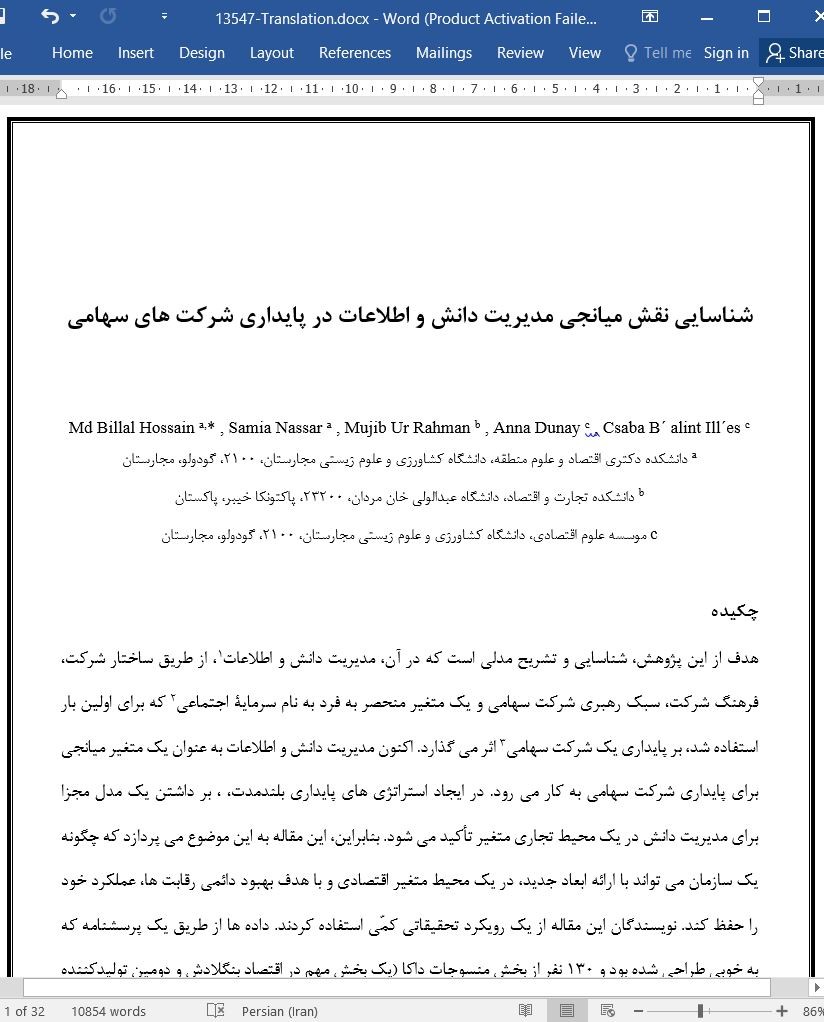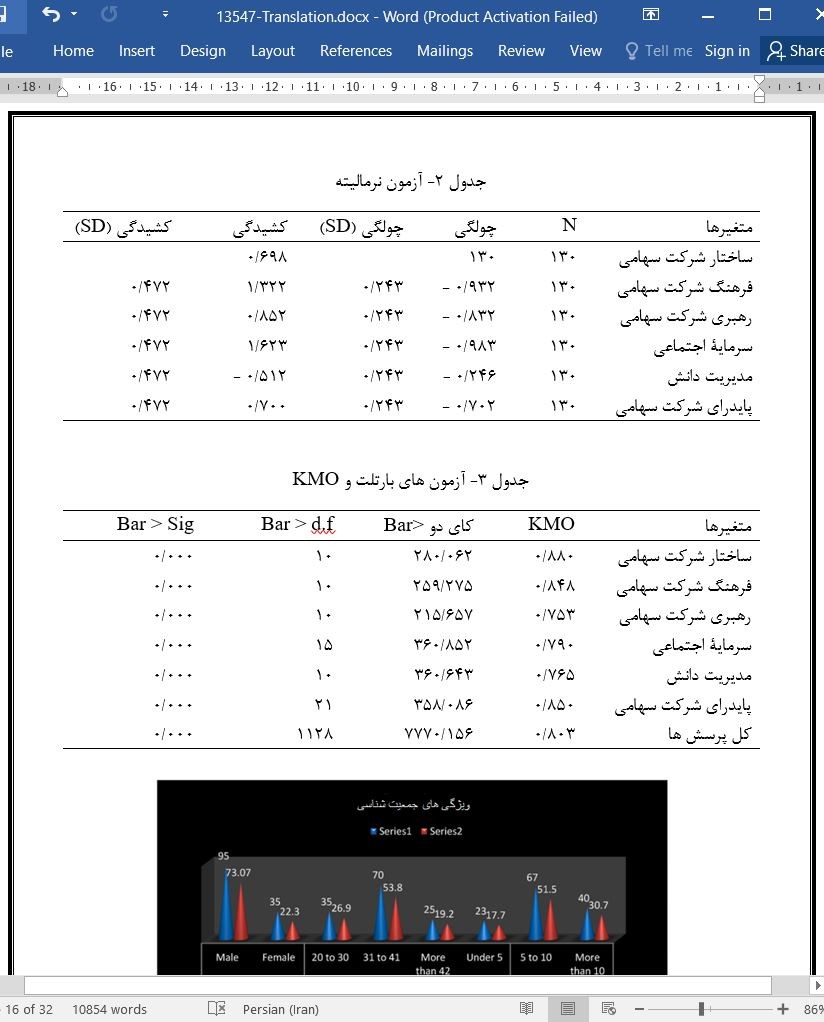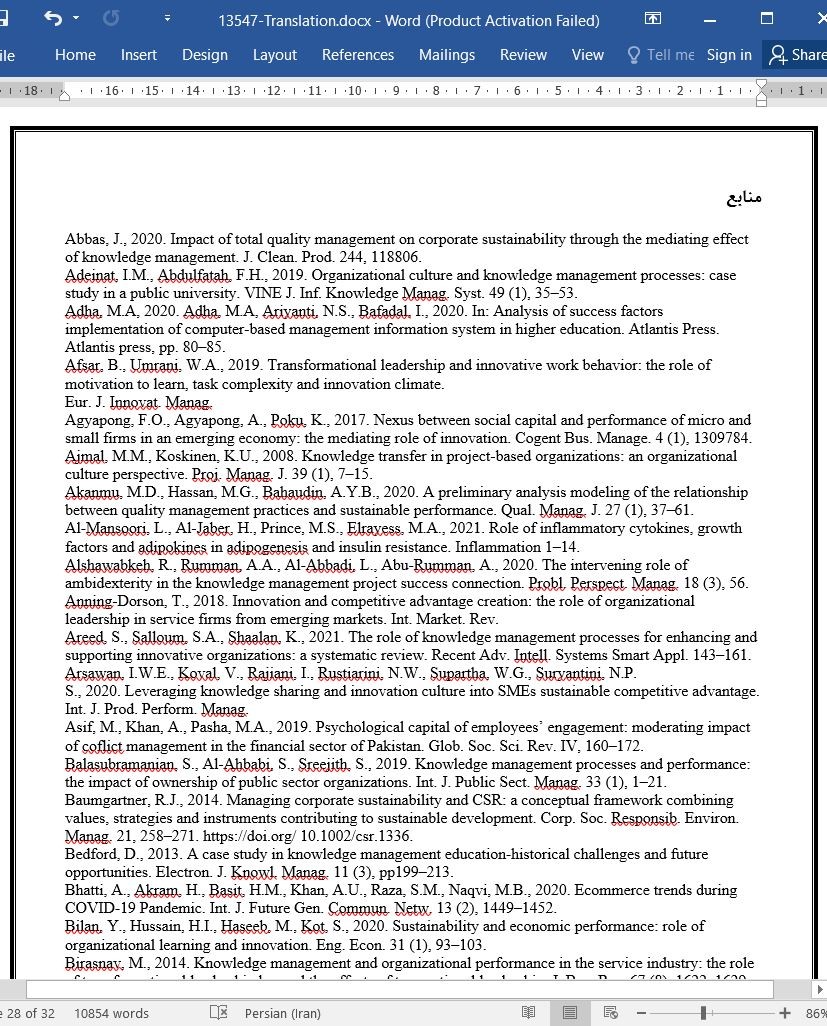
دانلود مقاله شناسایی نقش میانجی مدیریت دانش و اطلاعات در پایداری شرکت های سهامی
چکیده
هدف از این پژوهش، شناسایی و تشریح مدلی است که در آن، مدیریت دانش و اطلاعات ، از طریق ساختار شرکت، فرهنگ شرکت، سبک رهبری شرکت سهامی و یک متغیر منحصر به فرد به نام سرمایۀ اجتماعی که برای اولین بار استفاده شد، بر پایداری یک شرکت سهامی اثر می گذارد. اکنون مدیریت دانش و اطلاعات به عنوان یک متغیر میانجی برای پایداری شرکت سهامی به کار می رود. در ایجاد استراتژی های پایداری بلندمدت، ، بر داشتن یک مدل مجزا برای مدیریت دانش در یک محیط تجاری متغیر تأکید می شود. بنابراین، این مقاله به این موضوع می پردازد که چگونه یک سازمان می تواند با ارائه ابعاد جدید، در یک محیط متغیر اقتصادی و با هدف بهبود دائمی رقابت ها، عملکرد خود را حفظ کند. نویسندگان این مقاله از یک رویکرد تحقیقاتی کمّی استفاده کردند. داده ها از طریق یک پرسشنامه که به خوبی طراحی شده بود و 130 نفر از بخش منسوجات داکا (یک بخش مهم در اقتصاد بنگلادش و دومین تولیدکننده و صادرکنندۀ پوشاک آماده (RMG) در دنیا) به آن پاسخ دادند، جمع آوری شد. نتایج نشان دادند که پایداری شرکت سهامی ارتباط معنی داری با ساختار، فرهنگ، سرمایۀ اجتماعی و سبکِ رهبریِ شرکت سهامی دارد. نقش میانجی مدیریت دانش و اطلاعات، در رابطۀ بین فرهنگ سازمانی و عملکرد پایدار نیز یک نقش حیاتی است، و ارتباط بین روش رهبری و عملکرد پایدار نیز بسیار مهم می باشد. یک متغیر جدید به نام سرمایۀ اجتماعی نیز شناسایی شد. ایجاد ارزش و نوآوری در منابع علمی نیز برای تئوری های مدیریت دانش و پایداری شرکت، که دولت ها و قانون گذاران باید از آن تبعیت کنند، ضروری است.
1. مقدمه
پایداری یک شرکت سهامی عبارت است از توانایی یک سازمان در تأمین نیازها و انتظارات سازمان های (مشتریان و ذینفعان) دارای مدیریت مؤثر (Ferdig, 2007) در طولانی مدت، و همچنین حفظ این مدیریتِ مؤثرِ سازمانی از طریق آگاهی دادن به کارمندان (Farooq, 2019).
بحث پیشرفت پایدار ، از سی سال پیش در پاسخ به تغییرات منابع و جوامع جهانی آغاز شد. در سال 1972 کنفرانس استکهلم دربارۀ جوامع انسانی، نقطۀ عطفی برای این آگاهی شد که فعالیت های انسانی به محیط زیست ضرر می زنند و تمدّن را به خطر می اندازند (Yadav and Bethard, 2019).
در اقتصاد جهانی، بزرگ ترین شرکت های سهامی جهان متوجه شده اند که درآمدهای کوتاه مدت ضمانتی برای موفقیت در یک بازار رقابتی نیستند و بنابراین سیاست حداکثر کردن سودهای کوتاه مدت باید با ایجاد یک استراتژی پایدار بلندمدت، به کار گرفته شوند (Rebeka and Indradevi, 2015; Mahdi et al., 2019). در نتیجه، برای یک تجارت، تمرکز بر ضمانت عملکرد پایدار از طریق متعادل کردن نتایج محیطی، اجتماعی و مالی، از ضرورت بیشتری برخوردار است.
11. محدودیت ها و تحقیقات آتی
دستیابی به پایداری شرکت سهامی از طریق مدیریت دانش در منابع تجربی و تئوریکی به خوبی بیان شده است. ولی هنوز عملیات مدیریت استراتژیک به همراه مدیریت دانش (که از سرمایۀ اجتماعی به عنوان میانجی در پایداری شرکت در SME بنگلادش استفاده می کند) مورد توجه اندکی قرار گرفته است. اول اینکه، مطالعه مقدماتی درباره عوامل و روش شناسی تحقیق، این پژوهش را محدود کرد. دوم، ارزیابی مالی در این تحقیق وجود نداشت که باید در تحقیقات آتی لحاظ شود. سوم، چون نمونۀ مورد مطالعه فقط از یک گروه در صنعت پوشاک بنگلادش انتخاب شده بود، ممکن است مواردی در گروه های دیگر از دست رفته باشند. بنابراین، پژوهش های آتی باید به طور کلی بر تجارت های کوچک، متوسط، و میکرو تمرکز کنند. چهارم، در این پژوهش، به ویژگی های خاص شرکت توجهی نشد. برای رفع این محدودیت، باید در تحقیقات آینده، اثر اندازه و مالکیت شرکت بر ارتباط بین مدیریت دانش و پایداری شرکت بررسی شود. در نهایت، مدلی که در این پژوهش ابداع شد می تواند برای صنایع دیگر هم استفاده شود. در نتیجۀ طبیعت چند بُعدی این پژوهش ، یک تحقیق طولی باید برای آزمون تغییرات در عملکرد مالی یک شرکت سهامی و ارتباط آن با پایداری شرکت و مدیریت دانش به عنوان میانجی ها، انجام شود.
Abstract
This study aims to elaborate and recognize a model in which knowledge management practices affect corporate sustainability via corporate structure, corporate culture, corporate leadership style, and a unique variable social capital, used for the first time. Knowledge management is now used as a mediating variable for corporate sustainability. Creating long-term sustainable strategies emphasizes the need for a distinctive model of knowledge management practices in a rapidly changing business environment. Therefore, this paper delivers insights on how an organization can sustain its performance by addressing new dimensions due to the changing socio-economic environments and the pursuit of incessant improvement of competition. The authors used a quantitative research approach. Data is collected through a well-designed questionnaire from 130 respondents from Dhaka's textile sector, a significant sector of Bangladesh's economy and the world's second-largest ready-made garment (RMG) manufacturer and exporter. The result revealed that corporate sustainability is significantly related to corporate structure, culture, social capital, and corporate leadership styles. The mediated role of knowledge management in the link between organizational culture and sustainable performance is also crucial, and the relationship between leadership style and sustainable performance is also vital. A new variable known as social capital is also identified. Giving value and novelty to the academic literature also confirmed knowledge management and corporate sustainability theories that governments and regulators should follow.
1. Introduction
Corporate sustainability is the ability of the organization to meet its customers’ and other stakeholders’ maintaining effective management organizations (Ferdig, 2007) of the needs and expectations over an extended period while maintaining such effective management of the organization through employee awareness (Farooq, 2019).
Sustainable development was initiated 30 years ago in response to resource and global environmental challenges. The Stockholm Conference on the Human Environment in 1972 marked a turning point in the awareness that human activities harm the environment, endangering civilization (Yadav and Bethard, 2019).
In a globalized economy, the world’s largest corporations have realized that short-term earnings are not a guarantee of success in a highly competitive market, and thus the policy of maximizing shortterm profits must be complemented with the creation of a long-term sustainable strategy (Rebeka and Indradevi, 2015; Mahdi et al., 2019). As a result, it is becoming more necessary for businesses to focus on guaranteeing sustainable performance by balancing financial, social, and environmental outcomes.
11. Limitation and future research contribution
Corporate sustainability through knowledge management is welldocumented in the empirical and theoretical literature. Still, strategic management practices combined with knowledge management, which uses social capital as a mediator of corporate sustainability in Bangladeshi SMEs, have received little attention. Preliminary research on the research methodology and factors restricted this investigation. Secondly, there is a lack of financial assessment in the present study, which should include in future research aims. Thirdly, as the study’s sample was gathered from just a subset of Bangladesh’s textile garment industry, there’s a chance it missed out on some of the players. As a result, future studies should focus on small, medium, and micro textile businesses in general. Fourth, no consideration was given to the company’s specific features in this investigation. Research in the future should examine the influence of company size and ownership on the connection between knowledge management and corporate sustainability in order to solve this constraint. Finally, the model created in this study might be applied to other industries. As a result of this research’s cross-sectional nature, a longitudinal study should be done to examine changes in a corporation’s financial performance and its linkages with corporate sustainability and knowledge management as mediators.
H1. Knowledge management is significantly affected by a strong corporate culture.
H2. Knowledge management is significantly affected by the practices of transformational corporate leadership.
H3. A strong corporate culture has a significant effect on corporate sustainability.
H4. Transformational corporate leadership style is significantly influencing corporate sustainability.
H5. Knowledge management has significant effect on corporate sustainability.
H6. The relationship between corporate culture and sustainability is mediated by Knowledge management.
H7. The relationship between transformational corporate leadership and corporate sustainability is mediated by Knowledge Management.
H8. A strong corporate structure has a significant effect on corporate sustainability.
H9. Social capital is significantly enhancing corporate sustainability.
H1. مدیریت دانش به میزان زیادی تحت تأثیر یک فرهنگ قوی در شرکت است.
H2: مدیریت دانش به میزان زیادی تحت تأثیر عملیاتِ رهبری تحوّلی در شرکت سهامی است.
H3. یک فرهنگ قوی، اثر بزرگی بر پایداری شرکت سهامی دارد.
H4. روش رهبری تحوّلی اثر بزرگی بر پایداری شرکت سهامی دارد.
H5. مدیریت دانش و اطلاعات اثر بزرگی بر پایداری شرکت سهامی دارد.
H6. مدیریت دانش، میانجیِ ارتباط بین فرهنگ شرکت و پایداری است.
H7. مدیریت دانش، میانجی رابطۀ بین رهبری تحوّلی شرکت سهامی و پایداری شرکت است.
H8. ساختار قوی یک شرکت سهامی، اثر مهمی بر پایداری شرکت دارد.
H9. سرمایۀ اجتماعی به میزان زیادی سبب افزایش پایداری شرکت سهامی می شود.
Corporate structure
Corporate culture
Corporate leadership
Social Capital
Knowledge management
Corporate Sustainability
Total
چکیده
1. مقدمه
2. فرضیه ها و پیش زمینه
3. روش ها
4. اطلاعات آماری
5. تحلیل عاملی تأییدی
6. سنجش مدل: تحلیل شاخص های برازش
7. مدل درونی : ارزیابی مدل ساختاری
8. بحث
9. نتیجه گیری و پیشنهادات
10. نوآوری
11. محدودیت ها و تحقیقات آتی
سهم و نقش نویسندگان
تضاد منافع
دسترسی به داده ها
منابع
Abstract
Keywords
1. Introduction
2. Theoretical background and hypotheses
3. Methodology
4. Demographic information
5. The confirmatory factor analysis
6. Model measurement: analysis of fit indices
7. Inner model: Evaluation of structural model
8. Discussions
9. Conclusions and recommendations
10. Novelty
11. Limitation and future research contribution
CRediT authorship contribution statement
Declaration of competing interest
Data availability
References
این محصول شامل پاورپوینت ترجمه نیز می باشد که پس از خرید قابل دانلود می باشد. پاورپوینت این مقاله حاوی 18 اسلاید و 5 فصل است. در صورت نیاز به ارائه مقاله در کنفرانس یا سمینار می توان از این فایل پاورپوینت استفاده کرد.
در این محصول، به همراه ترجمه کامل متن، یک فایل ورد ترجمه خلاصه نیز ارائه شده است. متن فارسی این مقاله در 7 صفحه (1700 کلمه) خلاصه شده و در داخل بسته قرار گرفته است.
علاوه بر ترجمه مقاله، یک فایل ورد نیز به این محصول اضافه شده است که در آن متن به صورت یک پاراگراف انگلیسی و یک پاراگراف فارسی درج شده است که باعث می شود به راحتی قادر به تشخیص ترجمه هر بخش از مقاله و مطالعه آن باشید. این فایل برای یادگیری و مطالعه همزمان متن انگلیسی و فارسی بسیار مفید می باشد.
بخش مهم دیگری از این محصول لغت نامه یا اصطلاحات تخصصی می باشد که در آن تعداد 50 عبارت و اصطلاح تخصصی استفاده شده در این مقاله در یک فایل اکسل جمع آوری شده است. در این فایل اصطلاحات انگلیسی (تک کلمه ای یا چند کلمه ای) در یک ستون و ترجمه آنها در ستون دیگر درج شده است که در صورت نیاز می توان به راحتی از این عبارات استفاده کرد.
- ترجمه فارسی مقاله با فرمت ورد (word) با قابلیت ویرایش و pdf بدون آرم سایت ای ترجمه
- پاورپوینت فارسی با فرمت pptx
- خلاصه فارسی با فرمت ورد (word)
- متن پاراگراف به پاراگراف انگلیسی و فارسی با فرمت ورد (word)
- اصطلاحات تخصصی با فرمت اکسل



